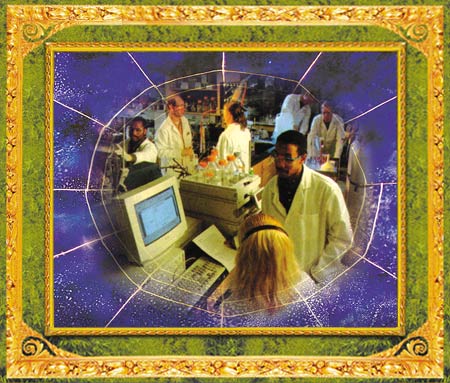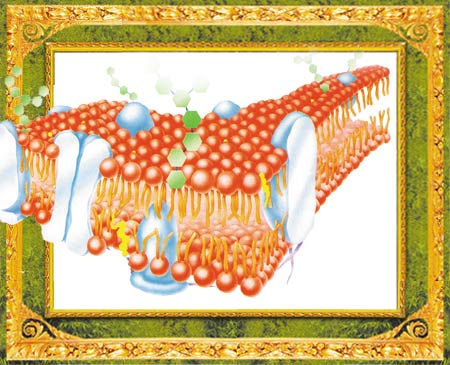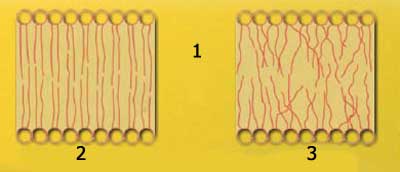Bigotry: The Dark Danger
The Miracle in the Cell Membrane

DOWNLOAD THE BOOK
CHAPTERS OF THE BOOK
- Foreword
- Introduction: The Consciousness Beyond Matter and The Col Lapse of Mechanism
- The Miniature Factories Comprising Our Bodies: The Cells
- The Cell's Complex Structure Can not Be Explained in Terms of Coincidence
- Superior Creation in The Structure of The Cell Membrane
- Complex Transportation Systems in The Cell Membrane
- The Selective Permeability of The Protein Channels in The Cell Membrane
- Selectivity in Nerve Cells
- Signal Selection in Traffic of Data Among Cells
- Selection in The Immune System's Cells
- Vital Selections in The Blood
- The Importance of The Creation in The Cell Membrane in Terms of Multi-Cellularity
- The Delicate Balance in Substances Selected in The Body
- The Cell Membrane Invalidates Claims of The Theory of Evolution
- Conclusion: Allah Pervades Everywhere With His Wisdom
< <
14 / total: 15
The Cell Membrane Invalidates Claims of The Theory of EvolutionEvolutionist Myths Concerning the Origin of LifeAccording to Darwinist scenarios, the first living cell arose in a "primordial soup," a liquid environment where certain organic molecules co-existed. Many Darwinists suggest that this primordial soup was oceans or lake. In the scenario, simple organic molecules in the primordial soup formed amino acids, which later turned into molecules able to copy themselves by forming proteins. But there is no evidence for this tale of chemical evolution whose different versions have been defended for the last 100 years. No such process has ever been observed. Furthermore, it is now known that the atmosphere's general structure is unsuited for the formation of amino acids, the simplest building blocks of life, and that for proteins to come into being by coincidence is mathematically impossible. However, Darwinists refuse to accept Creation and continue to believe in this chemical evolution story.
According to their scenario, which lacks any scientific foundation, the cell membrane—which would protect the first organic molecules and other cell organelles that formed the basis of the primordial cell—must all have come into being spontaneously, simultaneously.
Statements made by the evolutionist biologist Hoimar von Ditfurth are an example of Darwinists' biased views on this subject:
In referring to the complex, conscious selection mechanisms in the cell membrane, this well-known evolutionist also engages in forced evolutionary explanations. Offering no evidence at all, his approach is basically "Since we are alive today evolution must have emerged from this apparently contradictory state of affairs." His statements also constitute a significant example of evolutionists' poor scientific logic. Instead of drawing conclusions in the light of known findings, evolutionists regard the theory as irrefutable dogma. Von Ditfurth's statements might begin in a clearer form, thus: "Since we are alive, and have made it clear from the outset that we will accept no other explanation than the theory of evolution. . ." Once again, it emerges that the sole basis for the theory of evolution is not scientific proof, but a belief held for philosophical reasons. Evolutionists perform experiments on the cell membrane, fondly dreaming that it might have come into being by chance. Despite invalid experiments that fail to square with scientific data, they still make evolutionist interpretations. In one experiment performed with that aim in mind, a group of researchers from the University of California, directed by university graduate student Charles Apel, maintained that in fresh water in a laboratory environment, they had obtained membrane-structured blebs, structures that proved that life could appear spontaneously in fresh waters.83 These claims are unscientific, however, nothing more than biased interpretations put forward in the light of evolutionists' preconceptions. We shall examine the reasons for this in detail in the following pages. The Membrane Produced in the Laboratory is Not as Complex as the Cell Membrane
Up to this point evolutionists have maintained that life emerged in the oceans, in salt waters. Yet in experiments carried out in salt waters, no membrane ever appeared. Fresh water was used in Apel's experiment, and obtained blebs with a membranous structure. That these were obtained in the laboratory offers no support for the theory that the DNA, the cell, or the organelles and proteins within it formed spontaneously in water. 1. The laboratory membrane does not possess the features of the cell membrane. Of course, certain chemical and physical effects can align molecules in water, depending on whether they are hydrophilic or hydrophobic.). Yet this membrane bears no resemblance to the cell membrane, because the cell membrane has selective permeability between the inside and outside of the cell and possesses the complex gate systems to make this possible. Evolutionists, however, portray the cell membrane and molecules like DNA as simple structures and thus suggest that these structures came into being by chance. That is why they seek to depict the simple membrane produced in the laboratory as the first stage in this far more complex structure. However it is impossible for the membrane obtained in the laboratory to evolve into the cell membrane over the course of time. In order to see this, consider just one of the many attributes of the cell membrane.
In order for the cell membrane, consisting of fat molecules, to perform all of these processes, it must know all the activities and developments inside the cell, produce a list of all necessary or harmful substances, keep stocks under control, and maintain a superior memory and decision-making ability. In addition, it must also develop a system for transporting large molecules without harming them, and to form itself accordingly. It is impossible for coincidence to organize unconscious molecules flawlessly and construct an extraordinarily complex system. Even scientists, who possess millions of dollars' worth of equipment and the most advanced technology, are able to produce only a membrane that has no function and resembles an envelope with a few molecules inside. How could unconscious molecules and coincidence succeed where scientists have failed?
In order for the cell membrane, consisting of fat molecules, to perform all of these processes, it must know all the activities and developments inside the cell, produce a list of all necessary or harmful substances, keep stocks under control, and maintain a superior memory and decision-making ability. In addition, it must also develop a system for transporting large molecules without harming them, and to form itself accordingly. It is impossible for coincidence to organize unconscious molecules flawlessly and construct an extraordinarily complex system. Even scientists, who possess millions of dollars' worth of equipment and the most advanced technology, are able to produce only a membrane that has no function and resembles an envelope with a few molecules inside. How could unconscious molecules and coincidence succeed where scientists have failed? 2. The formation of the cell membrane is hardly the only subject for which evolutionists can provide no explanation. They allege that the primordial cell membrane formed in the primordial soup, after which molecules in that membrane turned into exceedingly complex molecules capable of replicating themselves. Yet they do not explain how that might have happened. Even prominent evolutionists admit that such an evolution is impossible. One of these, Dr. Leslie Orgel, an evolutionary biochemist from the California Salk Institute, says: Pre-biotic soup is easy to obtain. We must next explain how a pre-biotic soup of organic molecules, including amino acids and the organic constituents of nucleotides evolved into a self replication organism... I must admit that attempts to reconstruct this evolutionary process are extremely tentative. 84 Each of the structures and organelles that make up the cell possesses very complex features. The probability of any one of these emerging by chance is zero. Indeed, scientists' efforts for decades have all ended in failure. Not even the smallest component of the cell can be replicated and constructed in the laboratory. Darwinists' Attempts to Portray the Cell Membrane as a Simple Structure
Another study that fell into error, an experiment carried out by a group of researchers at NASA's Ames Research Institute maintained that these structures possessed the features of membranous structures found in all living things. When the content of the experiment is examined, however, it's clear that the structures that emerged definitely did not have the same properties as those of a living cell membrane. The microscopic balloons that emerged as a result of this study can immediately be recognized to be structures physically very different from the cell membrane. First, the balloons produced have a fatty structure consisting of a single layer. Every living cell membrane has a lipid structure consisting of two layers, the product of a common Creation. In the original paper, dated 30 January 2001 and published in the US National Academy of Science journal PNAS, the chemical structures were described as single layered soap bubble.85 No claim was made that the products of the experiment, described as amphiphilic (likening two different environments) because of their properties, were actually organic. As every biologist closely acquainted with the cell knows, the functions and organelles that make the life of the cell possible are extraordinarily complex. It is not yet possible for them to be produced or replicated by human beings. This experiment, in fact, once again made apparent the matchless structure of the cell membrane. It emerged that the cell membrane's double-layered lipid property could not be replicated even by the efforts and knowledge of dozens of scientists. Professor Werner Gitt, until recently a professor at the Federal German Physics and Technology Institute and head of the Information Technology Department, says this:
To be able to speak of a molecular chain possessing the membranous structures found in living things, it is essential that the cell's selective-permeable functions be replicated. Yet the results obtained in the laboratory—with an enormous budget and a human workforce and knowledge—went no further than producing sac-like blebs.
The membrane's function is not solely to enclose the cell. This membrane, giving the cell life with its vital functions, is the cell's brain in terms of its superior abilities, memory and the intelligence it displays. As touched on in earlier chapters, this membrane resembles a double-sided wall of fat molecules facing both inwards and outwards. Gates between these fat particle permit entry to and exit from the cell, and receptors permit the membrane to recognize the extracellular environment. These doors and receptors are composed of protein molecules. Located within the cell wall, they carefully supervise all entry to and departure from the cell.
To be able to maintain that living structures came about by coincidence, Darwinists first portray life as simple. In light of the scientific facts, however, life is actually exceedingly complex and has nothing to do with simplicity. Far from demonstrating coincidence emergence, experiments reveal that life cannot be replicated even by the advanced technology. Scientific findings, including this NASA experiment, refute the Darwinists' theory that life is the product of coincidence and confirm the fact of Creation. Almighty Allah, the All-Knowing Lord of infinite might, has created all living things, from the cell to human beings. In one verse, Allah reveals: "Say: "Have you thought about those you call upon apart from Allah ? Show me what they have created on the Earth."" (Surat al-Ahqaf, 4)
Unable to Account for the Origin of Life, Darwinists Hope for a Solution from SpaceDarwinist scientists, unable to obtain a cell membrane by artificial means, have sought an extraterrestrial solution. Some have referred to intergalactic substances to explain the origin of the double-layered compounds comprising the cell membrane.88 It was initially determined that carbon-containing meteors possessed compounds consisting of long hydrocarbon chains. Those who made these claims imagined that they'd found proof of their other claims. But subsequent analyses demonstrated that these compounds had formed after contact with the Earth. Recent laboratory experiments also support the view that amphiphilic substances have an earthly origin. 89 Darwinist researchers maintain that these compounds may be the first components of the cell membrane, and that when the right compounds emerged, then double-layered membranes could have arisen spontaneously. They assume that after primordial membranes formed, they became double-layered membranes consisting of phospholipids. These evolutionary models consist of gross simplifications. Darwinist researchers claim that the primordial membranes of the first cells consisted of aromatic hydrocarbons combined with octanoic and nonanoic acids. These views are deceptive, however. Octanoic and nonanoic acids can form double layers only when present in very high concentrations.90 This is incompatible with the primordial environment scenarios hypothesized by Darwinists. In order for octanoic and nonanoic acids to form double-layered membranes, therefore, they need powerful environmental conditions, at specific pH levels.91 If the solute's pH level departs from neutral values, then those double-layered membranes remain unstable. The temperature of the solution is also of enormous importance for the stability of double-layered membranes,92 and the stability of octanoic and nonanoic double layers also depends on the substances with the right molecular structure. For example, only of nonanol is included at a particular stage, then nonanoic acid double-layered membranes become stable. 93 That these exacting prerequisites arrived by means of meteors or comets, and then constituted the first cell membrane, is as impossible as it is for a river to flow uphill. All the various preconditions need to be met at the same time. If a double-layered membrane does form, the smallest changes in the surrounding conditions may cause it to lose stability and break down into micelles (the smallest molecular fragments in a solution) of no biological significance.
After the first phospholipids appear, therefore, the cell membrane's systems do not come together spontaneously. Some phospholipids produce only structures consisting of a single, double-layered membrane—and then under laboratory conditions, with the intervention and supervision of scientists. When formed in this manner, double-layered single membrane masses form hollow, spherical structures known as liposomes, which can survive for only short periods. Their stability is brief, and they gradually dissolve and merge together. 94 For example, when human red blood cells are kept above 37 °C (normal body temperature), they begin to deform. As a result of the phospholipid compound in the cell membrane changing, unhealthy compounds begin to emerge. Professor Norman Gershfield, a researcher at the National Institute of Health in the 1980s and 1990s, discovered that it was possible for cell membranes to form and to protect structures under specific conditions only and the physical and chemical conditions had to be adjusted with the greatest sensitivity.95 It is impossible for the physical processes active when the Earth first formed to have produced a chemically stable cell membrane. Even if random effects gave rise to the proper phospholipid compound, any variation in temperature in the cell membrane would ruin its structure. With that loss, the first cell would disappear.
As you see, the sensitivity of the cell membrane invalidates any scenarios proposed for the beginning of life and reveal the proofs of Allah's Creation at every stage. The formation of biological membranes and the absolute conditions that must be met for them to survive make it impossible for them to have come about naturally. No scientist has discovered how to produce a cell from inanimate substances. Professor Klaus Dose, head of the Johannes Gutenberg University Biochemistry Institute, who has researched the origin of life, expresses the problem:
The claim that "If earthly conditions were unsuitable, then the first cell came from space," is invalid. What makes it fundamentally impossible for the first cell to appear spontaneously is the cell's extraordinarily complex organization. No matter where one may go in outer space, the physical, chemical and mathematical laws that make it impossible for a cell to emerge by coincidence will never change. It is just as impossible for stones to produce a 10-storey building by randomly piling on top of one another. The scenario of the chance formation of the cell is equally impossible on any other planet in the universe. The cell consists of a great many organelles, each with complex structures of their own. The cell membrane allows specific compounds to enter or leave the cell, identifying substances that are harmful and refusing to admit them. Inside the cell are found the nucleic acids, DNA and RNA that contain all the information for life. These structures contain incomparably more information than even a large library. In the cell are also protein-producing ribosomes that use hundreds of proteins, all with different functions. The complexity of every component is quite extraordinary, yet none of these components serves any purpose on its own, and the cell cannot survive in the absence of any one. Therefore, the cell needs all its many organelles and components right from the outset. It is impossible, as the evolution theory would have us believe, for small components to combine in stages over millions of years. As you see, the single point that makes it impossible for the first cell to have formed is not the insufficient conditions on the primordial Earth, but the fact that the cell's intricate structure could never arise by coincidence. Therefore, how should something that cannot possibly occur on Earth be able to take place in space?
Footnotes82. Hoimar Von Dithfurt, Im Anfang War Der Wasserstoff ("Secret Night of the Dinosaurs"), Vol.3, (pp. 36-37 in Turkish edition). 83. http://astrobiology.arc.nasa.gov/news/expandnews.cfm?id=1368; Daily inSight, Academic Press, 17 April, 2002. 84. Leslie E. Orgel, "Darwinism at the very beginning of life," New Scientist, 15 April 1982, p. 150. 85. Jason P. Dworkin, David W. Deamer, Scott A. Sandford, Louis J. Allamandola, "Self-assembling amphiphilic molecules: Synthesis in simulated interstellar/precometary ices," Proceedings of the National Academy of Sciences, No. 93(3), ABD, 30 January 2001, pp. 815–819. 86. Werner Gitt, In the Beginning Was Information, CLV, Bielefeld, Germany, 1997, p. 236. 87. W. Thorpe, "Reductionism in Biology," Studies in the Philosophy of Biology, 1974, pp. 116-117. 88. David W. Deamer, Elizabeth H. Mahon, Giovanni Bosco, "Self-Assembling and Function of Primitive Membrane Structures," Early Life on Earth: Nobel Symposium, ed. Stefan Bengtson, No. 84, New York: Columbia University Press, 1994, pp. 107-123; David W. Deamer, "Membrane Compartments in Prebiotic Evolution," The Molecular Origins of Life: Assembling the Pieces of the Puzzle, ed. André Brock, Cambridge: Cambridge University Press, 1998, pp. 189-205. 89. Jason P. Dworkin, David W. Deamer, Scott A. Sandford, Louis J. Allamandola, "Self-assembling amphiphilic molecules: Synthesis in simulated interstellar/precometary ices," Proceedings of the National Academy of Sciences, no. 93(3), ABD, 30 January 2001, pp. 815–819; Ron Cowen, "Life's Housing May Come from Space," Science News, Vol. 159, No. 5, 3 February 2001, p. 68. 90. David W. Deamer, Elizabeth H. Mahon, Giovanni Bosco, "Self-Assembling and Function of Primitive Membrane Structures", Early Life on Earth: Nobel Symposium, ed. Stefan Bengtson, no. 84, pp. 107-123. 91. Ibid. 92. William R. Hargreaves, David W. Deamer, "Liposomes from Ionic, Single-Chain Amphiphiles," Biochemistry, No. 17, 1978, pp. 3759-3768. 93. Charles L. Apel, et al., "Self-Assembled Vesicles of Monocarboxylic Acids and Alcohols: Conditions for Stability and for the Encapsulation of Biopolymers," Biochimica et Biophysica Acta, 2001. 94. Barry L. Lentz, et al., "Spontaneous Fusion of Phosphatidylcholine Small Unilamellar Vesicles in the Fluid Phase," Biochemistry, No. 26, 1987, pp. 5389-5397. 95. N. L. Gershfeld, "The Critical Unilamellar Lipid State: A Perspective for Membrane Bilayer Assembly," Biochimica et Biophysica Acta, No. 988, 1989, pp. 335-350. 96. Klaus Dose, "The Origin Of Life: More Questions Than Answers," Interdisciplinary Science Reviews, Vol. 13, No. 4, 1988, pp. 348-349.
|
||||||||||||||||||||||||||||||||||||||||||||
14 / total 15
You can read Harun Yahya's book The Miracle in the Cell Membrane online, share it on social networks such as Facebook and Twitter, download it to your computer, use it in your homework and theses, and publish, copy or reproduce it on your own web sites or blogs without paying any copyright fee, so long as you acknowledge this site as the reference.












